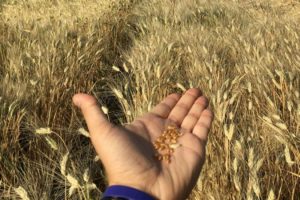Highlights of plant science 2017. Sept-Oct
The last week of the year is the time to look back and reflect. We like to take this opportunity to recognize the good work done by the plant science community. During this week we’ve been reminding you of some of the big stories and successes that came from our community. These stories were highly accessed through the ASPB and Plantae.org blogs, our many social media sites, and our journal websites. We hope you enjoy this look back at what has been an eventful and productive year in plant science. Check out the highlights from the first part of the year here, here, here and here.
 Our top blog post in September, “I don’t know how she does it,” explored the challenge of balancing career and parenthood, particularly as it impacts women’s careers. Several women who “have it all” shared their strategies for success, with the hope of passing on the colleted wisdom to future generations. It’s an inspiring and touching set of essays which you won’t want to miss.
Our top blog post in September, “I don’t know how she does it,” explored the challenge of balancing career and parenthood, particularly as it impacts women’s careers. Several women who “have it all” shared their strategies for success, with the hope of passing on the colleted wisdom to future generations. It’s an inspiring and touching set of essays which you won’t want to miss.
You know you’ve made it when Ed Yong writes about your research, so cheers to Moyroud, Wenzel et al. and the rest of team Glover for the terrific write up in The Atlantic, “Flowers Have Secret Blue Halos That Bumblebees Can See.” Pigments made the news again, with the evolutionary history of betalaine biosynthesis (Lopez-Nieves et al) garnering write-ups in the New York Times in two languages (How beets became beet red and Por qué el betabel se volvió rojo escarlata).
A few other stories that saw lots of social media shares:
 The ongoing challenges of banana pathogens got an excellent write-up in the Washington Post in Bananapocalypse: The race to save the world’s most popular fruit.
The ongoing challenges of banana pathogens got an excellent write-up in the Washington Post in Bananapocalypse: The race to save the world’s most popular fruit.- Mounce et al. explored how botanic gardens support plant diversity conservation, concluding that improvements could be made in the representation of tropical and especially non-vascular species.
- Because plant genomes can be highly repetitive, assembling them from short-reads can be extremely difficult. Long-read technology such as that developed by Nanopore can greatly facilitate genome assembly, and it can also be cost-effective, as demonstrated by Schmidt et al. in De Novo Assembly of a New Solanum pennellii Accession Using Nanopore Sequencing.
- I’m not sure this 100% counts as plant science, but there was a lot of interest in a story on NPR featuring a new book “Flora of Middle Earth: Plants of J.R.R. Tokein’s Legendarium.” Anything to combat plant blindness, right? Hopefully it will inspire interest in the Flora of Earth-Earth too.
Another highly shared post was a beautiful article in National Geographic Magazine: “Netherlands – this tiny country feeds the world”. As you might expect, the photographs are stunning, but the article also features plant science research from Wageningen University & Research (WUR), including short videos of graduate students describing their research. If you missed this article the first time around, here is your chance to read about the amazing agricultural accomplishments that can be achieved when governments support research and entrepreneurship. And 2018 is a special year for WUR as it will be celebrating its 100th anniversary with a year-long celebration.
An article from The Plant Cell about natural variation of vitamin E levels got a lot of attention. This article, by et al., used a genome-wide association study (GWAS) to identify genetic loci that contribute to vitamin E accumulation in seed oils from maize. Because seed oils are a major source of vitamin E in humans, this study provides a great foundation for improving access to adequate vitamin E in the diet.
This year the ASPB journals have been developing new ways to support our authors, such as by working with them to produce short, accessible articles that summarize their work. We’ve trialed accessible abstract-like summarizes on our Plantae page (“In a Nutshells“) and beginning in 2018 we’ll be publishing these with Plant Cell articles. In September, we created a channel in Medium called “Plant Cell Extracts” to post selected research summaries written by our editorial team. Please follow and share our fledgling foray!
Spotlight: Small Team Pushes Bread Wheat Genome Assembly Forward (By Megan Lynch*)
Assembling a genome sequence takes a fantastic amount of computing power and numerous scientists working on analyzing the data and fitting together the puzzle pieces. As a result, full genome sequencing projects have heretofore been an international effort involving several large teams. The bread wheat genome poses steep challenges in that it is not only hexaploid, not only very large indeed, but it has many long repeating sequences that complicate efforts to match the pieces back together. 2012 saw the first published attempt to sequence the Triticum aestivum (bread wheat) genome. Large teams continued working on it, but in November a team of six scientists (Zimin et al.) solved these knotty problems before the consortium did. This could herald a new era of smaller, more nimble genome projects. Read more in this Nature News article.

Megan Lynch* (@may_gun) has a BA in Art from UCLA and is a returning student in Biology at Pasadena Community College (Pasadena, CA, USA). She is a longtime member of California Rare Fruit Growers and hopes to go to grad school to learn fruit breeding. She’s currently studying Ceratonia siliqua and its history in California.
Join us tomorrow for the final end-of-year highlights as we say goodbye to 2017 and welcome in a brand new shiny year.



